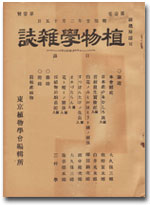巻号一覧

72 巻, 851 号
選択された号の論文の6件中1~6を表示しています
- |<
- <
- 1
- >
- >|
-
II. 暗期前に与えた近赤外光の影響滝本 敦, 池田 勝彦1959 年 72 巻 851 号 p. 181-189
発行日: 1959年
公開日: 2006/12/05
ジャーナル フリー1) アサガオの子葉に16時間の暗期を与える前に, 近赤外光(FR)を与えると花芽形成が抑制される。しかし12時間の暗期前にFRを与えると, その照射時間が4時間以下の場合のみ花芽形成の促進がみられる。
2) 暗期前に与えた赤色光 (R) は花芽形成に対してほとんど影響を及ぼさない。
3) 暗期前に与えたFRの花芽形成抑制効果は暗期直前にRを与えることにより消却される。
4) 10ルックスのFRを多く含む白熱電灯光 (IL) もFRと同じような効果を示すが, FRよりも花芽形成促進効果が強く, 抑制効果が弱い。
5) 10ルックスのFRをほとんど含まない昼光色螢光燈光 (FL) を12時間暗期前に与えるといちじるしく花芽形成が促進される。同じ光を16時間暗期前に与えると, 照射時間が長い場合のみ, わずかに花芽形成が抑制される。
6) 暗期前に与えたFR, ILおよびFLの作用に関し二, 三の考察を行なった。抄録全体を表示PDF形式でダウンロード (809K) -
M. DURAIRATNAM1959 年 72 巻 851 号 p. 190-192
発行日: 1959年
公開日: 2006/12/05
ジャーナル フリーMahabale (1950) はデンジソウ科の Regnellidium diphyllum ではじめて乳組織を観察したが, 筆者はさらに諸器宮における乳組織の分布について観察した。切片はサフラニンとライトグリーンか, またはヘマトキシリンとライトグリーンで染めた。
大きくなった茎の乳組織は, 表皮では主に毛の形で, また下表皮細胞, 皮層の外側, 篩管, 髄の柔組織中では管の形で分布している。古い茎においては, 外皮層, 髄で乳組織の原形質の増加がみられ, これらの細胞の色もまた淡褐色から濃褐色に変わる。横断面における乳組織はエピセリウム状の4~5細胞の中央に位置し, これらの乳組織は上下に向かって短かく伸び, 格子模様を形成する。
葉柄の横断面における乳組織は, 下表皮, 皮層の内側, 篩管柔組織中, 中心柱内に存在し, また表皮では腺の形で見出される。乳組織のあるものは, 外皮層と維管束を放射状に結んでおり, それらは通気組織の横隔内で終つている。乳組織は根では見出されなかった。要するに, この植物における乳組織は2つの種類からできている。
1) 表皮の倒卵形の盤状細胞と 2) 皮層の内•外層, 横隔の細胞, 篩部, 中心柱内にある柔組織における, 長くて垂直的に不規則に延びて連なった乳管とである。しかし, それらの分布は厳密に決ったものとは思われない。抄録全体を表示PDF形式でダウンロード (374K) -
市村 俊英, 西条 八束1959 年 72 巻 851 号 p. 193-202
発行日: 1959年
公開日: 2006/12/05
ジャーナル フリー海洋の基礎生産に関する研究は最近いちじるしく発展が見られる。特にSteemann Nielsen によるC14の導入は外洋の基礎生産の測定も容易ならしめた。しかるに西北太平洋については, わずかに二三の研究を見るにすぎない。著者等は黒潮ならびに親潮の基礎生産の測定を行なったので, ここにその一部である本邦南方黒潮海域 (図1) の1957年8月, 1958年5月の測定結果について報告する。
植物プランクトンの現存量としてクロロフィルの定量を行なった。沿岸部で5月0.6-2.1mg./m. 3, 8月0.4-2.Omg./m.3, 外洋では5月0.23-0.56mg./m.3, 8月0.08-0.2mg./m.3であった (図3)。明らかにいわゆる island mass effect の現象が見られる。クロロフィルの垂直分布は湖沼程には明瞭な成層は認められなかった (表1-2)。海域の透明度とクロロフィル含量との間には直線的相関が得られた (図4)。
これは海洋ではプランクトンガ水中光度を弱める主要要因となり, 湖沼よりも植物プランクトンのエネルギー効率の大きいことを示している。
植物プランクトンの生産力測定にはC14を用いた。光飽和における生産力は沿岸部で1-4mg.C/m.3/hr. 外洋で0.1-0.6mg. C/m.3/hr. を示した。一日の生産量を tank 法および chlorophyll 法で求めた結果, 沿岸部で0.3-0.5g.C/m.2/day, 外洋で0.07-0.15g.C/m.2/day を得た。この値は大西洋の Sargassoや北海の Fladen 海域で報告されている/直に近い。著者等によって調査された黒潮海域は他の海域に比して基礎生産力はかなり低いと考えられる。抄録全体を表示PDF形式でダウンロード (1026K) -
柴岡 弘郎, 八巻 敏雄1959 年 72 巻 851 号 p. 203-214
発行日: 1959年
公開日: 2006/12/05
ジャーナル フリー前報においてFeSO4がアベナ屈曲試験に対し促進的に働らくことを述べた。今回はこの鉄イオンの促進作用の機構を明らかにするために行なった実験についての報告を行なう。
FeSO4は10-5Mで0.05mg./l. のIAAによってひきおこされるアベナ子葉鞘切片の伸長を増大させる。伸長試験後, 検液中に残っているIAAをはかると10-∞~10-5MのFeSO4をふくむ検液からは完全にIAAが消失しているが, 10-4M以上のFeSO4が加えられていた検液中にはIAAが残っている。FeSO4はNAAによる切片の伸長に対しては促進的でない。FeSO4の伸長促進作用はIAA濃度の高い時はほとんど現れず, IAA濃度の低い時に明りょうに現れる。短時間の伸長試験ではこの促進作用は見られず, 長時間の試験ではじめていちじるしく現れる。FeSO4は伸長促進作用を示す濃度 (10-5M) でもアベナ子葉鞘からとったIAA酸化酵素によるIAAの破壊を阻害する。などが明らかにされ, これらの実験事実から,伸長試験に対するFeSO4の促進作用は, FeSO4がオーキシンの分解を抑制するため, という結論がひき出された。
また, 屈曲試験については, FeSO4のIAA, またはNAAによってひきおこされるアベナ子葉鞘の屈曲に対する促進作用は, 短時間のテストでより明りょうに現れる。FeSO4はきまった長さの子葉鞘円筒の上側の切口においた寒天片中のIAA, またはNAAが円筒組織内を通過して円筒の下側の切口に附着させた寒天片中に移動するのを促進する。などが観察され, 屈曲試験に対するFeSO4の促進作用は, FeSO4が子葉鞘へのオーキシンの浸入速度を高めるため, という考えがもたらされた。
ここで, 屈曲試験に対するFeSO4の促進作用が, FeSO4が子葉鞘へのオーキシンの移動を促進する, ということによる可能性の大きいことが示されたので, FeSO4をアベナ屈曲試験の感度をあげるために利用することは, 未知の生長物質の検出に際しても有効な手段であるといえよう。抄録全体を表示PDF形式でダウンロード (1122K) -
トフンタケの交配系武丸 恒雄1959 年 72 巻 851 号 p. 215-219
発行日: 1959年
公開日: 2006/12/05
ジャーナル フリーThe mating system of Psilocybe coprophila was analyzed, using K-and T-stocks. As shown in Tables 1a and 2, in legitimate matings, clamps were observed microscopically both in the contact zone between two mycelia and on either side of it. Clamps were also found in all common B-factor matings, but in these pairings the formation of clamps was restricted to the contact zone only. Therefore, when only the contact zone is examined for clamps, a bipolar mating pattern is obtained. However, when the mycelia on either side of it are also tested for clamps, tetrapolarity is unmasked.
All matings where clamp-bearing hyphae had been observed were tested for their capacity to produce fruit-bodies under the same culture conditions. The same test was also done for individual monosporous mycelia. Some of the mycelia gave rise to haploid fruit-bodies bearing ample basidiospores, all of which were of the same mating type as the parent mycelia. As shown in Table 1b, perfectly developed fruit-bodies with abundant spores were obtained not only in all legitimate matings but also in some common B-factor matings. The fruit-bodies from legitimate matings produced spores of all four mating types; whereas, well-developed fruit-bodies from common B-factor matings produced only spores of the two parental types (Table 3b).
Pairings between the monosporous mycelia derived from common B-factor matings showed bipolar pattern, where clamps were found only in the contact zone, but never on either side of it (Table 3 a).
Barrages are irregularly manifested in common A-factor matings, in common B-factor matings, and in other matings (Tables 1a and 2). Thus, the barrages in this fungus seem to be of haphazard appearance but not of heritable characters.抄録全体を表示PDF形式でダウンロード (549K) -
林 孝三, 菊池 正彦, 岡本 好正1959 年 72 巻 851 号 p. 220-229
発行日: 1959年
公開日: 2006/12/05
ジャーナル フリーThe formation of anthraqulnone pigments in the mycelia of Penicillium islandicum Sopp. NRRL 1175 during cultivation on different kinds of media was studied in detail by means of paper chromatography.
1) Seven pigments, erythroskyrin, skyrin, oxyskyrin, chrysophanol, pigment-0.8, pigment-C and flavoskyrin, were detected in the mycelium grown on complete medium (Table 1).
2) Within a range of pH 5.4 to 7.6, the formation of the mycelial pigments did not depend on pH-value of the culture media used (Table 2). However, the occurrence of the pigments, in particular pigment-0.8 and flavoskyrin, was found to be affected by the nutrients added to the medium (Table 2, 3 and 4).
3) After several generations obtained by successive inoculation of conidia on the minimal medium, the biosynthetic capacity of the mold to form both pigment-0.8 and flavoskyrin is completely abolished, and can not be recovered even after inoculation on the complete medium (Table 4).
4) From the data obtained in relation to the sequence of pigment synthesis in the mycelia (Table 5-8), it is suggested that skyrin is a primary product in the biosynthesis of anthraquinone pigments and oxyskyrin is derived therefrom through oxidation of its 7-CH3 group. Both pigment-0.8 and flavoskyrin are probably formed in the final step of biosynthesis.
5) Since the structure of erythroskyrin remains unsettled, any final evidence could not be obtained at present for the biosynthetic interrelationship between erythroskyrin and other mycelial pigments, However, in view of the fact that the formation of skyrin takes place in growing mycelia even after erythroskyrin has ceased to be formed (Table 3 and 4), it is suggested that erythroskyrin is not involved in biosynthetic route of skyrin as an intermediate.抄録全体を表示PDF形式でダウンロード (1014K)
- |<
- <
- 1
- >
- >|